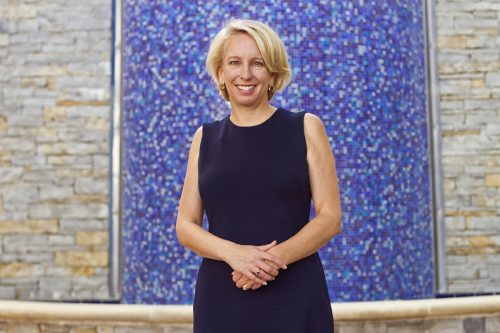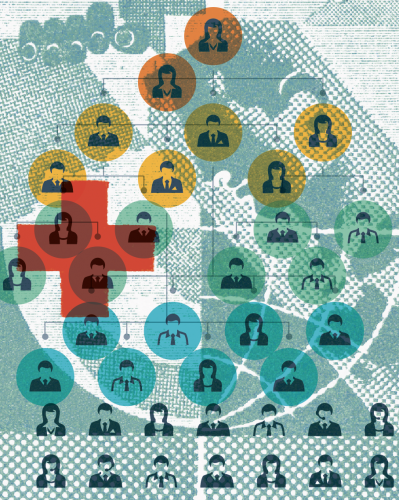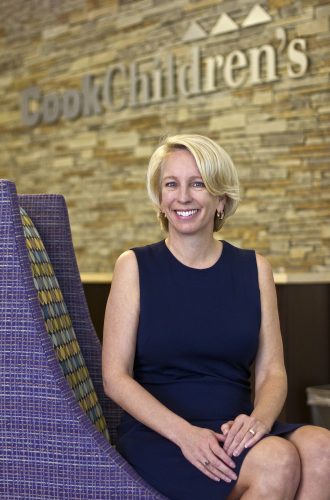Complexity Theory Helps Organizations Adapt
Mary Uhl-Bien, a business professor, finds collaboration is important in a fast-paced world.
Complexity Theory Helps Organizations Adapt
Mary Uhl-Bien, a business professor, finds collaboration is important in a fast-paced world.
When Fort Worth pediatrician Justin Smith asked the parents of his patients what changes they would like to see at his clinic, the parents said they wanted a dedicated waiting room for newborns, a child-size potty chair in the restroom and a telemedicine link.

Mary Uhl-Bien, the BNSF Railway Endowed Professor of Leadership in the Neeley School of Business, says downplaying hierarchy allows fresh ideas to surface in organizations. Photo by Mark Graham
But ideas are one thing and execution is another — especially when large institutions such as Cook Children’s Health Care System are involved. “Some of the ideas … didn’t fit with the cookie-cutter plan for building a practice in our system,” said Smith, director of primary care innovations at the children’s hospital.
Some people at Cook Children’s were unsure if the physical design changes were doable, Smith said, while others felt the changes wouldn’t fit templates meant to protect the hospital’s brand.
But Smith had studied, of all things, complexity theory — a field related to cybernetics, chaos theory and even studies of ants and bees — and it’s more germane to hospital work than most might think.
With complexity skills learned in a Neeley School of Business physician leadership course taught by Mary Uhl-Bien, the BNSF Railway Endowed Professor of Leadership, Smith found it easier to communicate with administrators, navigate hierarchies and get the families’ requests installed.
Uhl-Bien (yule-bean) is a leadership expert. The professor of management, having consulted for the likes of Walt Disney World and State Farm, has spent decades studying how large organizations react to unpredictable pressures. The most successful ones, she’s found, downplay hierarchy, which can make them more receptive to ideas from unexpected sources — such as the parents of newborns or a physician who isn’t top brass.
“Our management system and our organizational structures were developed for the industrial age,” Uhl-Bien said. “They were developed based on bureaucracy, and bureaucracy is a hierarchical order-and-control system. It’s [built] on old Newtonian logic based on predictability and planning and control.”

Illustration by Getty Images © CSA Images / Printstock Collection and appleuzr
But such systems work against adaptability to our fast-changing world. Take hospitals, for instance. In a health care environment that is in constant, drastic change — Uhl-Bien said it’s “in complexity” — employees’ and administrators’ ability to work within a less hierarchical environment is crucial to a constructive reaction.
The Affordable Care Act “is an issue, and the regulatory environment. Then you have the issue of telemedicine, you have wearable technologies, you have the changing doctor-patient relationship, you have issues of pay and pay for performance, transparency — and that’s just the tip of the iceberg,” Uhl-Bien said. “All of these things are swirling around, and as they’re swirling around, they mean we cannot operate in a very predictable way. We have to be adaptive.”
Uhl-Bien’s course, based on her research into dozens of successful and less successful companies, teaches doctors such as Smith to interact in ways that steer institutions away from rigid hierarchies and toward reacting productively to change and new ideas.
As health care organizations expand and consolidate to try to protect themselves from unstable insurance markets and legislation, Uhl-Bien said, physician leadership is key. Otherwise, there is a danger that their bureaucracies will grow too rigid to allow a nimble response to change.
Knowing the Context
Uhl-Bien began her career studying interpersonal relationships among leaders and employees and teaching executives about leadership. But by the late 1990s, the professor had grown restless with a line of research that she believed didn’t take context into account.
“I felt like we weren’t really telling [executives] what they needed to know, and we were oversimplifying,” Uhl-Bien said. Then she began to learn about how complex systems adapt to environmental pressures. In two words, she said, complexity equals rich interconnectivity. It denotes a system in which component parts interact and change each other in unexpected ways. Complexity and its implications for large organizations intrigued her.
“It takes complexity to beat complexity.”
Mary Uhl-Bien, BNSF Railway Endowed Professor of Leadership in the Neeley School of Business
In 2007, Uhl-Bien and her colleagues won a $300,000 grant from the management consulting firm Booz Allen Hamilton to study leadership and adaptability in health care. Over the next two years, the team studied six U.S. health care systems in depth, then moved to financial institutions, an aerospace company and a medical equipment manufacturer. What they found was that the systems reacted all wrong to the challenges they faced.
“The major finding was this: that health care is in complexity,” Uhl-Bien said. “When you’re in complexity, you need to respond with a complex, adaptive response.”
Instead, the organizations doubled down on control, spending huge sums to, say, script health care workers’ language or conduct surveys. Too often, the desired results didn’t materialize.
Instead, health care executives need to encourage networking within the organization, Uhl-Bien said. That includes making sure that people from different departments meet and that they learn to trust one another. It also means teaching them to take an exploratory rather than a directive approach to problem-solving; getting them to anticipate and work with, rather than quash, co-workers and bosses who object to new ideas; and making people comfortable with ambiguity and with partial successes.
Learning not to present ideas as all-or-nothing proposals is a big one for doctors, Smith said. “We might get away with that in clinical spaces, but if you’re talking about an organization, you kind of have to be happy with 60 percent or 70 percent of your plan,” the pediatrician said. “You’re not likely to come out of it with the plan exactly intact as the way you first thought it up. Physicians have a hard time with that.”
So which businesses are doing complexity right? Uhl-Bien named Apple under Steve Jobs, General Electric under Jack Welch and Gore-Tex maker W.L. Gore & Associates. For at least part of their history, these companies succeeded largely because of their adaptability. Their cultures encouraged energetic new groupings of people, ideas and resources to solve a problem; after the challenge was solved, the groups disbanded.
“It takes complexity to beat complexity,” Uhl-Bien said. “Each situation that faces you when pressures come in, it’s something different; you haven’t faced it before. It’s going to require agents — which is people, and resources, technology, ideas, whatever — to come together, and they form around that challenge that’s being presented to them. But when that challenge is met, it disbands. Those are networks. When you need the adaptability, the network kicks in. The rest of the time, the operational system keeps it running the way it should.”
Novel Solutions
Mary Waller, professor of management in the Neeley School of Business, studies how teams under high pressure — such as nuclear-power control crews and aviation cockpit crews — respond to unexpected events.
“What I’ve found, and I think this maps onto what Mary [Uhl-Bien] has found too … is those teams that are able to tolerate that ambiguity and not try to force-fit the situation into a protocol or a solution that they’ve already learned,” Waller said, “better understand the complexity and can create a novel solution, [and] those teams outperform others.”
Uhl-Bien’s research “is really incredibly appropriate for 21st-century work,” Waller said. “For 20th-century work, we wanted checklists and we wanted standardization. We wanted things to be done as fast [and uniformly] as possible. But the types of tasks that people were performing were in an environment and an economy that was nowhere near as complex as it is now.”
Putting it another way, organizations must learn to resist the temptation of fitting new problems into Procrustean beds.

Mary Uhl-Bien teaches a physician leadership course with the Neeley School of Business. Photo by Mark Graham
“We need to start training new physicians in how to work in a team from the very first day,” Waller said, “instead of training them [only] as individuals. And then they hit their internship or residency, and suddenly they’re a member of a team, and they know [almost] nothing about team dynamics.”
This approach is not without risk, of course. In one health care organization Uhl-Bien studied, the executive team managed to push quick adaptive change in response to shifting conditions. But their actions backfired.
“They were engaging the kinds of conversations that were needed,” Uhl-Bien said. “But they weren’t communicating it well or effectively, and one of the problems when you drive this change is that it goes to people’s fears.”
When the executives mishandled those fears, they soon found themselves removed from power. Uhl-Bien’s team dubbed this snap-back to equilibrium “the rubber band effect,” and it suggests that adaptability requires empathy and finesse.
Indeed, networking is about more than friendly human connection, Uhl-Bien said. The many perspectives, desires and needs within an organization create situations that traditional managers are taught to label “conflict” and to eliminate. That’s a mistake, she said, not the least because it invites pushback.
At the core of adaptive response to complexity is tension, Uhl-Bien said. “You have to engage the tension.” For example, a nurse and a doctor have different needs. Instead of one plowing over the other or holding back, they engage and try to come up with a solution that’s adaptive and is generated by that tension.
So far, adaptive response is working for Smith. “A lot of what the class is about is teaching providers the skills they need to effect change better, which translates to happier physicians when they feel like they’re part of a bigger plan,” he said. “There are some that really want to effect change on a bigger scale, and this class is giving providers that, which will lead to decreased burnout and a better organization as a whole.”

Your comments are welcome
1 Comment
In some ways the doctors’ theory dovetails well with Peter Drucker’s take on management.
Related reading:
Features
TCU Partnerships Shape the Future of Medicine
Leadership programs at two Fort Worth hospitals take physicians into uncharted territory.
Web Extras
TCU Magazine Podcast: Dr. Justin Smith
Dr. Justin Smith’s experience with the Advancing Healthcare Leadership program, a collaboration between TCU and Cook Children’s Health Care System, impacted him so much he wanted to teach a course.
Features
Physicians Find Value in Leadership Programs
Do business and leadership belong in medical school?